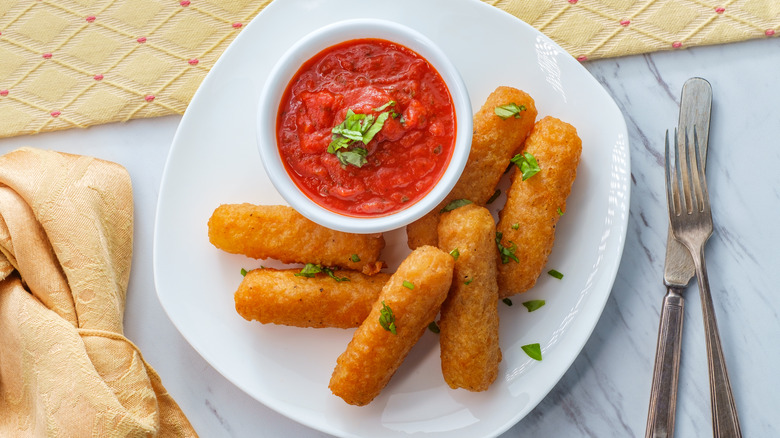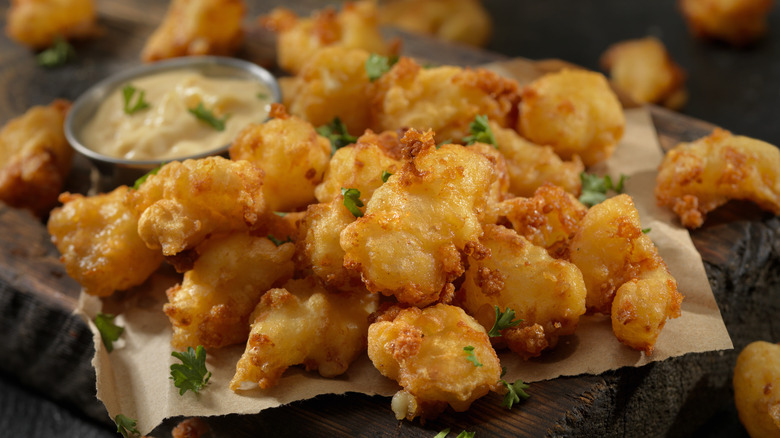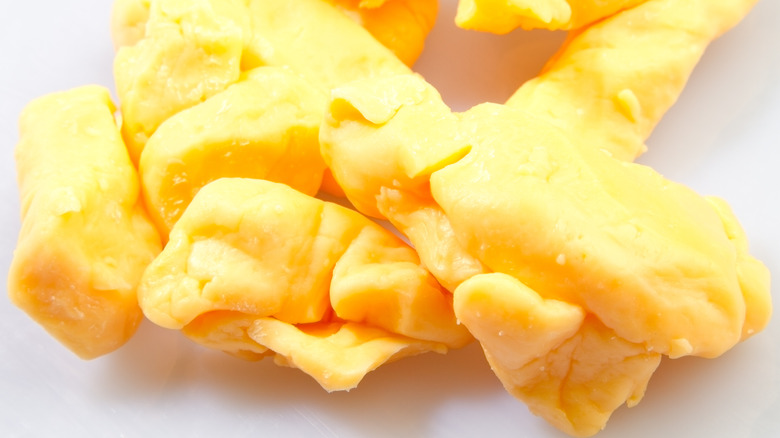What's The Difference Between Cheese Curds And Mozzarella Sticks?
Unless you're lactose intolerant (and maybe even if you are), there's a pretty good chance you're a fan of cheese. And why wouldn't you be? As long as you use it correctly, cheese seems to go with practically everything. The varieties and applications are seemingly endless, meaning there's a cheese-based dish for everyone. But there are two dishes in particular that you'll see a lot on restaurant menus now and which deserve special attention: Mozzarella sticks and cheese curds.
But while they're both cheese products, beyond that, they're far more distinct than perhaps some would give them credit for. Fried cheese curds and mozzarella sticks are conceptually similar, but they're very different products. For one thing, there's the fact that you don't even have to fry cheese curds; you can just eat them in their uncooked form. Mozzarella sticks? Not so much. But the differences go beyond that, starting with the fact they're not even made from the same kind of cheese.
Cheese curds and mozzarella sticks aren't the same kind of cheese
You know mozzarella sticks. You've had mozzarella sticks. Take a long, finger-shaped block of mozzarella, batter it, drop it in a deep fryer until the edges get crispy but the interior melts, then serve with marinara — that's a mozzarella stick. We aren't quite sure where they came from — some claim 15th-century France, but modern mozzarella sticks are likely an American creation from the 1970s — but they're beloved by diners everywhere and are one of the world's perfect bar snacks. But the key is right there in the name: They're made with mozzarella. Granted, you'll sometimes see cheese sticks made from provolone or some other type of cheese, but mozzarella sticks refer to the mozzarella variety.
Fried cheese curds, meanwhile, don't have to be made with a specific cheese — though the kind you'll find in stores or restaurants is usually made from cheddar. Much like mozzarella sticks, we don't know where they came from; there's evidence of everything from the Romans creating them to a 1758 cookbook to the 1975 Minnesota State Fair. But while fried cheese curds function the same way as mozzarella sticks in that you bread and deep fry them, the taste will be significantly different because you're using a different type of cheese.
Cheese curds are a totally different part of the process
Beyond that, the two are wildly different regarding the requirements for freshness. Mozzarella travels pretty well, and a lot of mozzarella sticks you'll get in restaurants will have been frozen. But cheese curds are best consumed when they're very fresh — which is why they're so popular in Midwestern states like Wisconsin, aka "America's Dairyland," where they're more likely to have been produced.
See, while commercially available fried cheese curds are usually baby cheddar, they aren't always a specific type of cheese. It's simply an interruption of the normal cheesemaking process. Cheesemaking involves separating the milk solids in milk from the liquid whey. Typically, these solids are processed repeatedly and then aged until they become the blocks of cheese you're familiar with. Cheese curds, though, stop after the separation; they're basically nugget-shaped milk solids that have been salted. Mozzarella sticks, by comparison, are made from fully processed cheese.
You don't have to fry them, either; you can just eat cheese curds straight up, and you'll know how fresh they are by how they squeak against your teeth. In fact, while fried cheese curds appear on menus, many Midwesterners particularly love just a straight-up snack of salty cheese curds. And who can blame them? They're delicious, no matter how you have them.


